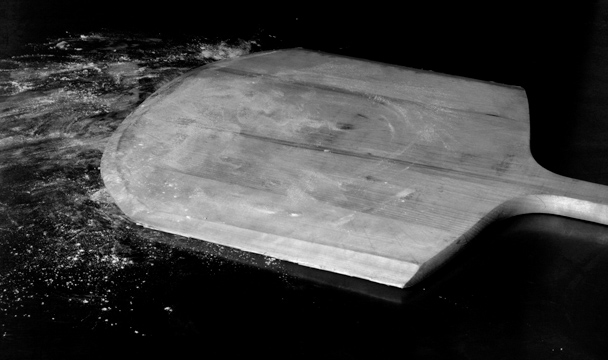The day I picked up my pizza peel from the post office and carried it home, many people reacted to the oversized aluminum spatula sticking out of my backpack.
“That for spanking?” asked a tired mom on the bus, within earshot of her rowdy kids.
“It’s for pizza,” I said. She looked confused and probably pictured me using it to thwack a pizza delivery man in the face. That’s where pizza comes from, isn’t it?
Not if you’re an ambitious idiot, like me. Even though I live in Chicago, where great pizza can be found on practically every corner, I’ve been attempting to perfect my own pizza-making skills recently. I recognize that this seems like the work of a simpleton, as if my next act will be opening up an ice factory in Oslo. But messing around with pizza at home is surprisingly rewarding—it involves a lot of little jobs (mixing dough, grating cheese, chopping onion) that can (and should) be farmed out to friends or family. Best of all, the liberty to think outside the box when it comes to toppings is exhilarating (I’m partial to “breakfast pizza,” with bacon and a fried egg, but go ahead—baked kale? Mackerel? Tomme de savoie? I’m not judging.)
The first step toward outstanding results is a pizza stone (or baking stone). I bought one for less than $20 at Sur La Table, and parked it in my oven (where it lives permanently, regulating and drying the heat). The stone, a porous slab formed in 2,000-degree heat, sucks moisture from the crust, making it extra toasted and crispy. It’ll perform similarly on bread, cookies, etc.
But with a beautifully assembled raw pie ready to bake, one encounters a problem: how to get it into the oven and onto the stone, which is heavy, extremely hot, and impossible to move or manhandle? This is the moment when the pizza peel comes to the rescue, serving its one purpose of transporting your pie from prep surface to oven.
That’s all it does.
Brief, targeted, and essential, the pizza peel is like the one guy on the set of the Mariah Carey music video whose only job is to spray her with 24-karat-gold-flecked bronzer between takes. And like spritzing Mariah’s body with gold, using the pizza peel is certainly the most exciting part of the project. Someone else gets the oven door, I crouch low holding my absurd pie-laden oar, and I attempt the classic gesture of the pizzaiolo—that short, fast jab needed to hop the pizza, intact, off the peel and onto the stone before slamming the door shut again.
Even with the requisite dusting of cornmeal or semolina on the paddle to help the pie slide without sticking, this action sequence takes practice, and the learning curve can be messy. Mysteriously, the pie might end up on the stone with the toppings somehow jumping ship. Or you might shuffle a little too hard and whip the pie clear over the stone to the back of the oven. This is when a nice bottle of wine comes in handy.
I prefer a metal peel. Though not as handsome and rustic as a wooden peel, the metal version slides beneath pies more easily. A tiny niche of specialty peels veers toward the silly (such as a Fender Strat model made specifically for people who like to bake in leather pants), but overall it’s such a primordial device that the farthest anyone has gone towards innovation might be Mario Batali, who ushers the paddle into the age of technology with a collapsible handle.
All told, a good pizza stone and peel can easily be bought for less than $40, a small price to pay for feeling like a legitimate, coal-smeared Neapolitan. And if the crusty pie you shovel off your hot pizza stone isn’t reward enough, wall-mount the peel in your kitchen and wait for your guests to ask, “Is that for spanking?”


